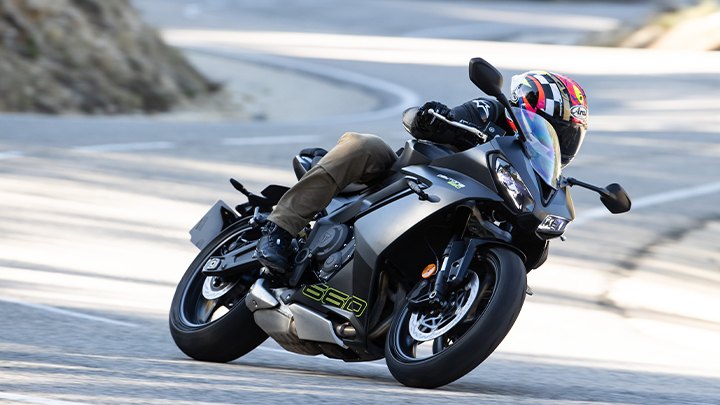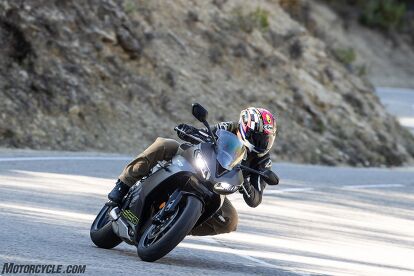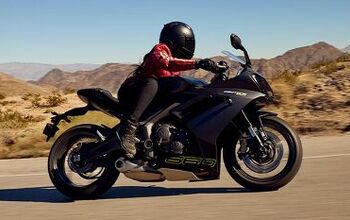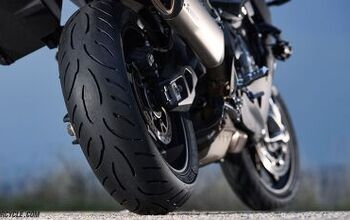2025 Triumph Daytona 660 Review – First Ride

Good things come in threes
There’s a reason why Trader Joe’s is beloved by so many when it comes to their grocery shopping. It boils down to a phenomenon known as decision paralysis. At your typical grocery store, for any particular item, you have dozens upon dozens of choices. Really, how many different kinds of toothpaste do you need? Trying to decide which one to get, when any of the options will do, overwhelms the brain and we end up getting nothing, thus causing choice paralysis. That’s the beauty of Trader Joe’s. They’ve streamlined the options so you can get in, pick your hot sauce, and move on.
2025 Triumph Daytona 660
The latest player in a crowded field, the Daytona 660 offers three-cylinder variety – and a huge value proposition – to a class mainly filled with Twins.
Editor Score: 86.5%
Engine | 18.5/20 | Suspension | 11.5/15 | Transmission | 9.5/10 |
Brakes | 8/10 | Instruments | 3.5/5 | Ergonomics | 8/10 |
Appearance | 9/10 | Desirability | 9/10 | Value | 9.5/10 |
Highs
- Another fantastic Triple with an equally slick transmission
- Surprisingly light on its feet
- Incredible value proposition
Sighs
- Ergos steer towards the aggressive side of the category
- The combined LCD/TFT gauge cluster could be better utilized
- Always-on ABS could be an issue if you plan on tracking it
What does any of this have to do with Triumph’s new Daytona 660? Well, thanks to Triumph, the burgeoning middleweight sportybike class now has another player, making your buying decision just a little bit more… paralyzing. In a class that includes the Honda CBR650R, Kawasaki Ninja 650, Yamaha R7, Suzuki GSX-8R, and Aprilia RS660, the Daytona 660 grows the field to six. How does it intend to stand out – and break you out of the choice paralysis slump? The same way Triumphs always have – by being different.
Triple Threat
In classic Triumph fashion, the Daytona 660 upends the middleweight sportybike class by introducing a Triple to what’s mostly a field of Twins (Honda’s 650 Four being the other exception). While there are plenty of critics of both Fours and Twins alike (oddly criticizing them both for having sewing machine-like qualities), it’s hard to think of anyone who doesn’t like the spice and excitement on offer from a three-cylinder. And that’s exactly what Triumph is banking on.
Sharing the same basic platform as the Trident 660, the Daytona turns up the wick to increase its performance by way of a new crankshaft, piston, and cylinder head with larger exhaust valves and a higher lift exhaust camshaft. There’s a larger airbox that now feeds three 44mm throttle bodies instead of the Trident’s single 38mm throttle body. The result is a 660cc Triple pumping out a claimed 93 horsepower and 51 lb-ft of torque (at the crank) – a 17% and 9% increase, respectively, compared to the Trident 660.
We covered all these changes to the Daytona 660 and more, and in detail, in our First Look piece, so be sure to check that out to get the full rundown of what makes the Daytona different from the Trident. In that story, we also compare some key stats and figures of the Daytona against its rivals. From here on out, we’ll (mostly) focus on what the Daytona is like to ride.
But before getting to the ride impressions, it’s important to point out one last thing. Apart from the performance proposition, the Daytona 660 also has to deliver a value proposition, as the hardcore sportbikes that spawned this resurging class have nearly priced themselves into extinction. At $9,195, only Kawasaki’s aging Ninja 650 ($8,299) is less expensive. The reality is, to bring a bike in this class to market, it has to come in under the $10,000 mark. To do that, concessions need to be made. As you’ll see, Triumph has made those concessions.
The obvious exception here is the Aprilia RS660. At $11,499 at the time of this writing, the higher price is reflected in its higher-spec components. Equip any of the contemporaries in this class with better parts and their price will go up, too. Then we spiral into an arms race the 600cc sportbike class is still struggling to recover from (with doubts that it ever will). This is exactly what Triumph (and we suspect the other OEMs as well) are trying to avoid.
The beauty here is that budget components have come a long way in the past 20 years and are wholly adequate for many riders. Not great, mind you. Just adequate. Keep that in mind as you read on.
Riding Impressions
A human’s heart rate and enthusiasm are proportional to the rpm of the three-cylinder engine in which they are operating. - Sir Issac Newton
I’m no historian, but I’m pretty sure Newton said that. Or at least he would if he had the chance to try one. There’s something invigorating about a three-cylinder engine wailing at full song. Especially when said wailing is being done in the picturesque hillsides in Alicante, Spain, where Triumph chose to hold the international press launch of the new bike. The distinctive note accompanied by the rate of propulsion never fails to please, and the sentiment is yet again true with the Daytona 660. Get the engine spinning and it’s impossible not to smile. Better still is the broad spread of power, with a considerable amount of torque available as low as 3,125 rpm and remaining all the way to redline.
Still, my seat-of-the-pants dyno feels as though the Triumph doesn’t have the same level of twist as the Suzuki GSX-8R, but it also doesn’t have the extra 116 cubic centimeters, either. Looking back at our GSX-8R review, we see the Suzuki does make more torque, but only just, its 57 lb-ft is barely more than the Triumph’s 51 lb-ft. However, the Suzuki reaches that number at 6,800 rpm whereas the Triumph gets there at 8,250 rpm. Internal and final drive gearing also muddy up the waters, but overall reflect what the butt dyno was saying.
Before diving too far into the engine performance and ride qualities, let’s take a step back. Actually, it’s more like let’s throw a leg over. The Daytona will appeal to many riders, including the newer and less experienced among us. These riders will appreciate the narrow junction between the seat and tank, which will make the 31.8-inch seat height feel shorter than it actually is. Getting the balls of both feet firmly planted on the ground at the same time was easy for my 5-foot, 8-inch frame, and shorter riders I talked to – both male and female – also had the same feeling.
One of the distinctions of this class is ergonomics that are more agreeable with everyday street riding versus the track-focused riding position pure sportbikes are known for. The Daytona’s knee bend isn’t extreme and is actually quite comfortable, despite being 50mm further back and 10mm higher than the Trident’s pegs. The bars are clearly lower than the Trident’s, with their mount built into the upper triple and its final positioning raised just a tad higher than the triple. With the luxury of having ridden the Yamaha R7, with its clip-ons placed below the triple, and the Suzuki GSX-8R, which has arguably the most neutral bar position in the class, the Daytona places the rider farther forward, closer in feel to the aggressive R7 but not quite as extreme.
But let’s get back to the engine. With a light pull on the (cable-operated) clutch lever, the Triple comes to life at the push of the start button. Ease off the clutch and the 660 pulls away with only a minor bit of throttle to get going. Once rolling along, I noticed a tiny bit of on/off throttle jerkiness, but this was mainly in traffic, at slow speeds, and in the first two gears. I’m not totally ruling out the possibility that this was driveline lash at play. After 3,000 rpm the connection from the right wrist to the back tire is seamless and clean, which only adds to the bike’s playful nature and makes you want to rev more and more. There’s no bi-directional quickshifter (it’s available as an option), but the Daytona shifts so smoothly without it that it’s almost not necessary. No seriously, the Daytona gearbox is up there as one of the smoothest-shifting transmissions I’ve ever sampled. It’s hard to muck it up, but just in case, a slip-and-assist clutch has your back when it comes to smoothing out all but the sloppiest of downshifts.
Common among many modern motorcycles, the Daytona included, is the addition of ride modes to vary the power depending on the ride or the conditions. The 660 has three ride modes available – Sport, Street, and Rain – which alter the throttle sensitivity but not peak power. You have the option to disable traction control entirely, but not how strong or weak TC intervenes. ABS, however, is always on. Since conditions on our ride were nearly perfect, Rain mode wasn’t much use. That said, I tried it anyway to confirm that yes, power delivery is noticeably muted in relation to how much twist you’re giving with the right wrist. Street mode quickens the throttle sensitivity and is a good option for commuting, especially if you find yourself in traffic. As expected, Sport mode provides the liveliest throttle but is not twitchy or hard to manage. More experienced riders could easily get away with Sport mode in traffic. Though it’s clearly the most advantageous when playing on the fun roads, as the snappy power delivery is metered to perfection. You can toggle through each mode with a simple push of the M(ode) button. Selecting a different mode requires a closed throttle and the push of another button.
There’s a bit of a buzz in the bars above 8,000 rpm, but I didn’t find it to be annoying or distracting. However, compared to the ultra well balanced GSX-8R with virtually no vibrations at all from its twin counterbalanced engine, everything else will seem like a paint mixer. If you find yourself revving the Daytona that high on the street, then you’re either accelerating or playing on twisty roads. It’s on these twisty roads where the Daytona surprised me. Its claimed 443-pound wet weight, partially a result of its steel frame, swingarm, and the abundance of plastic bits to cover up those steel parts, is not light for the class. Add in the non-adjustable Showa SFF-BP fork and preload-adjustable shock, and there shouldn’t be much to write home about here.
Despite the weight, the Daytona handles much lighter than it should. Direction changes are quick and easy, with side-to-side transitions remarkably quick as well. This wasn’t given much fanfare (actually none) during any of our discussions with the Triumph team, but I think a lot of the credit has to do with the extremely sharp 23.8º rake and 3.24 inches of trail. Geometry numbers that steep will lend itself to quick steering, while the 56.1-inch wheelbase – among the longest in the class – helps provide stability mid-turn.
What about the budget suspension? Well, it’s remarkably up to the job for nearly every kind of riding situation. Yes it’s damped on the softer side, but that’s the tradeoff for a bike built to a price point. That said, you really have to be pushing the pace, or be on the heavy side of the weight spectrum, to approach the limits of what the Showa pieces can do. If, like me, you find yourself separated from your ride group because you forgot to zip up your airbag and you pull over to do so, you can experience for yourself what it’s like to ride at this, uh… unadvisable…pace.
With the help of the sweep rider who picked me up and led me back to the group, we rode as if the Spanish back roads literally were our racetrack. Sweep riders usually get left with the unenviable task of riding at a snail’s pace so no one gets left behind, but now, with the freedom (and encouragement!) to catch back up to the group, my particular guide rode like the Spanish roads were his personal TT course. In doing so, I confirmed my absolute adoration for the Triple engine for all the reasons I noted above, but I also found myself hitting the limits of the suspension. Neither end could compress or rebound fast enough, creating this kind of floating sensation, similar to a wallowing effect but in slow motion. Of course the suspension could be better, but remember the theme here: Value. At any sane pace, and even a lightly spirited one, the stock pieces are competent enough.
Hauling ass also requires you to slow down eventually, and the Triumph-branded J.Juan four-piston, radial-mount calipers actually do a nice job of bringing the party back down to Earth. The pad compound is more aggressive than that in the Trident and you can feel that extra bite. But once the pace picks up and you find yourself needing to be more demanding on the brakes, you start to veer into ABS territory when it may not necessarily be needed. Granted, you need to be moving at a rapid pace on the street to start playing with that kind of braking power, but those kinds of braking thresholds can easily be reached at the track. And without the ability to disable ABS (at least from the push of a button anyway), this could be a problem.
Despite the cost-cutting measures, the Daytona is equipped with steel-braided brake lines – a feature some of its rivals don’t have despite their higher price tags. An adjustable lever is a nice touch, but the weak link here is the axial master cylinder (instead of a radial one). The extra slop at the lever when you’re squeezing at the max isn’t great and almost feels like it has rubber lines. But now I’m nitpicking and losing sight of one of the bike’s main pillars. What’s that word again? Ah, yes. Value.
Negatives
There’s a lot to like about the Daytona 660, but it certainly isn’t a bike without its faults. I’m not including the suspension or master cylinder on this list because they’ll actually work quite well for the vast majority of riders and their inclusion was a conscious decision to meet a price point.
My biggest gripe is with the ergonomics. Sure, the 660 is more comfortable than the Daytona 675 and 765 before it, but there’s still a considerable amount of weight placed on the rider’s wrists. For a bike aimed at being a comfortable sportbike, in a field of other comfortable sportbikes, its bar position almost seems counter to that point.
A close second on my list of complaints is the gauge display. A combination of an LCD bar graph tachometer and speedo sitting atop a small TFT menu screen with the gear position indicator dominating the view, the gauge display leaves a lot of empty white space on the table and seems like an inefficient use of the space. Considering less expensive motorcycles (KTM 390s come to mind) now feature full five-inch TFT displays, why can’t the Daytona? If it did, the information could be better organized, the space better utilized, and the numbers I actually want to see when I look down would be easier to read at a glance.
My last gripe is a weird one, but I’m annoyed by the plastic cover Triumph added over the steel frame spar to give the appearance (from afar) that the frame is actually aluminum and stylized. As someone who values function over form, to me the added trim piece means one more superfluous panel to remove if I want to work on the bike – and who knows how many other superfluous pieces there are. On the bright side, you hopefully won’t need to be digging past those panels very often as the Daytona has 10,000-mile service intervals, and 20,000-mile valve service intervals!
Three’s Company
With those gripes out of the way, let me make something clear: after a full day riding the Daytona 660 through some amazing Spanish roads, I’m a big fan of the bike. The three-cylinder engine has been a favorite of mine since the original 675, and as much as I enjoy the various parallel-Twins and their different firing orders, there’s nothing like a Triple to inject some life into this class. The Daytona is dripping with character, handles better than it should, and is a genuine blast to ride. The fact it costs $9,195 seems like the ultimate cherry on top.
Triumph offers over 30 genuine accessories to make the bike your own, but if you’re looking to upgrade performance bits like the suspension, the aftermarket will be your best bet. However, Triumph is working together with Peter Hickman Racing in the UK to build a racing version of this bike to compete in the Pirelli Sportbike National Championship, competing alongside the British Superbike Series (the rough equivalent to the MotoAmerica Twins Cup). PHR will then be the distributor for those race parts (either as a kit or sold a la carte) for those who want them.
I’m going to stop short of saying the Daytona is my favorite in the class since I have yet to ride all of the contenders back-to-back, but Triumph sure is making a strong case for itself. The value-to-performance proposition is hard to beat, but the field is so stacked with quality competition. We’re going to do our best to avoid paralyzation of choice once we’re able to get all the contenders together at the same time.
In Gear

- Helmet: Arai Corsair-X Schwantz
- Jacket: Alpinestars GP Plus V4
- Airbag: Alpinestars Tech-Air 3
- Pants: REV’IT! Davis Jeans
- Gloves: Alpinestars Phenom
- Boots: Alpinestars SP2 Riding Shoes
2025 Triumph Daytona 660 Specifications | |
|---|---|
Type | Liquid cooled, inline 3-cylinder,12 valve, DOHC, 240° Firing order |
Capacity | 660cc |
Bore | 2.91” (74.04mm) |
Stroke | 2.01” (51.1mm) |
Compression | 12.05:1 |
Maximum Power | 94 HP (70 kW)(95PS) at 11,250 rpm |
Maximum Torque | 50.89 LB-FT (69 Nm) @ 8,250 rpm |
Fuel System | Multipoint sequential electronic fuel injection with electronic throttle control |
Exhaust | Stainless steel 3 into 1 header system with low single sided stainless steel silencer |
Final Drive | X-ring chain |
Clutch | Wet, multi-plate, slip & assist |
Gearbox | 6 speed |
Frame | Tubular steel perimeter frame |
Swingarm | Twin-sided, fabricated steel |
Front Wheel | Cast aluminum alloy 5 spoke, 17 x 3.5 in |
Rear Wheel | Cast aluminum alloy 5 spoke, 17 x 5.5 in |
Front Tire | 120/70 ZR 17 |
Rear Tire | 180/55 ZR 17 |
Front Suspension | Showa 1.61” (41mm) upside down separate function big piston (SFF-BP) forks, 4.33” (110mm) Wheel travel |
Rear Suspension | Showa monoshock RSU, with preload adjustment, 130mm wheel travel |
Front Brakes | Twin 12.2” (310mm) floating discs, 4 piston radial calipers, ABS |
Rear Brakes | Single 8.66” (220mm) fixed disc, single piston sliding calipers, ABS |
Instruments | Multi-function instruments with color TFT screen |
Length | 82” (2083.8mm) |
Width (Handlebars) | 28.97 (736mm) |
Height Without Mirrors | 45.08” (1145.2mm) |
Seat Height | 31.88” (810mm) |
Wheelbase | 56.12 “ (1425.6mm) |
Rake | 23.8° |
Trail | 3.24” (82.3mm) |
Wet weight | 443lbs (201kg) (@90% fuel volume) |
Fuel Tank Capacity | 3.7gal (14 liters) |
Fuel Consumption | 57.6 mpg (4.9litres / 100 km) |
CO2 Figures | 113 g/km |
Emissions Standard | EURO 5+ |
Service interval | 10,000 miles (16,000 km) /12 months service interval, whichever comes first |
We are committed to finding, researching, and recommending the best products. We earn commissions from purchases you make using the retail links in our product reviews. Learn more about how this works.
Become a Motorcycle.com insider. Get the latest motorcycle news first by subscribing to our newsletter here.

Troy's been riding motorcycles and writing about them since 2006, getting his start at Rider Magazine. From there, he moved to Sport Rider Magazine before finally landing at Motorcycle.com in 2011. A lifelong gearhead who didn't fully immerse himself in motorcycles until his teenage years, Troy's interests have always been in technology, performance, and going fast. Naturally, racing was the perfect avenue to combine all three. Troy has been racing nearly as long as he's been riding and has competed at the AMA national level. He's also won multiple club races throughout the country, culminating in a Utah Sport Bike Association championship in 2011. He has been invited as a guest instructor for the Yamaha Champions Riding School, and when he's not out riding, he's either wrenching on bikes or watching MotoGP.
More by Troy Siahaan




















































































Comments
Join the conversation
Troy, can you share with us your thoughts on how the new Daytona compares the the previous 675R and 765R Daytona bikes? I had a 2012 675R and that bike made more power and had great Ohlins suspension, etc. This new Daytona 660 seems like a major step down, almost as if it doesn't deserve the name Daytona. Would love to know your thoughts, hopefully you're allowed to speak freely!
Fun review and nice pics Troy. You were a bit soft on the soft suspension and didn't mention the slightly vague front end under pressure.
As for the comments above, this is not a super sport, largely because the market does not want one. The 660 fills a valuable market spot at a good price. It is what many folk actually want and need.
Mind you a fully faired Street triple might sell very well...